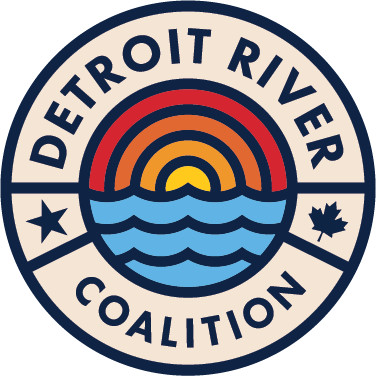From its role in facilitating the industrialization of Windsor and Detroit to the Great Lakes Water Quality Agreement and its designation as an Area of Concern, the Detroit River has a rich and vibrant story to tell. Situated in the heart of the Great Lakes Basin, the Detroit River connects Lake St. Clair and Lake Erie, as well as the cities of Detroit, Michigan and Windsor, Ontario. This 51 kilometre/32 mile waterway is the busiest international border crossing point between Canada and the United States and is a key transportation route in the Great Lakes system.
The river is truly a shared resource bringing the people of two nations together. The over 6,000 years of First Nation use and 300 years of European settlement have endowed the Detroit River with many exceptional and unique cultural heritage values. The River is designated an American Heritage River and a Canadian Heritage River, the only river to have this dual designation.
There are five Michigan tributaries to the Detroit River which include the Rouge River, Connors Creek, Monguagon Creek, Ecorse Creek and the Frank and Poet Drain. In Ontario, the three tributaries include Turkey Creek, Little River and Canard River. There are twenty-eight islands within the Detroit River channel. On the American side they include Belle Isle, Calf Island, Celeron Island, Edmond Island, Elba Island, Elizabeth Park, Fox Island, Grassy Island, Grosse Ile, Humbug Island, Hickory Island, Mamajuda Island, Meso Island, Mud Island, Powder House Island, Round Island, Stony Island, Sturgeons Bar, Sugar Island, Swan Island and Zug Island. On the Canadian side, the islands include Bois Blanc Island, Crystal Island, Fighting Island, Grass Island, Peche Island and Turkey Island.
Fishing is an extremely popular recreation activity throughout Ontario and the Great Lakes system and the Detroit River is no exception. It is quite common to see anglers at any of the bridges at the mouths of tributaries or along the fishing platforms, piers, docks, and marinas in Windsor, Detroit, LaSalle and Amherstburg. Public access to fishing in all of the communities along the river on both sides, coupled with the climate, diversity and numbers of fish found in the river, easily make the Detroit River one of the best urban fishing opportunities in North America. City piers, docks, waterfronts, and bridges have been designed to accommodate fishing and at most times of the year are packed with anglers.
The Detroit River is best known for its excellent walleye fishery that is particularly productive in the spring. Walleye fishing takes place upriver near shore and island environments. In the lower river, fishing tends to focus on white bass, northern pike, and other species in the main channels near Stony and Bois Blanc Island. Large catches of white bass are taken east of Grosse Ile, west of Stoney Island, and adjacent to Sugar Island. The Detroit River – Lake St. Clair system generates in excess of $10 million annually through recreational fishing.
The recreational value of the River and its importance to local residents is reflected in the many waterfront parks on both the Canadian and American shore as well as in the river itself in the form of several island parks. The beauty of the riverfront makes these same parks prime locales for many of the region’s annual festivals. Trails, benches, open areas, events, gardens, and even works of art make the Detroit River waterfront a place with recreational appeal for almost every segment of the population.
When the Windsor-Detroit area underwent rapid industrialization at the turn of the 20th century, the Detroit River became notoriously polluted. These environmental issues have been identified as being related to, or the cause of, the impairment of several beneficial uses. The 1970s and 1980s saw the development of a massive conservation effort aimed at cleaning up the Detroit River.
The Great Lakes Water Quality Agreement (GLWQA) between Canada and the United States, first signed in 1972, commits both countries to protect and restore the Great Lakes Ecosystem.

